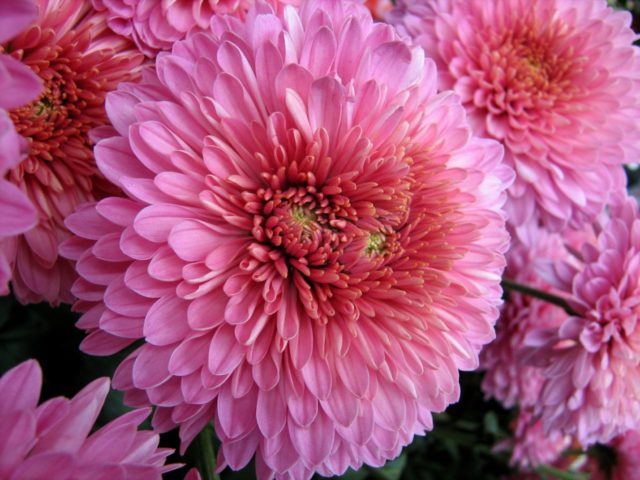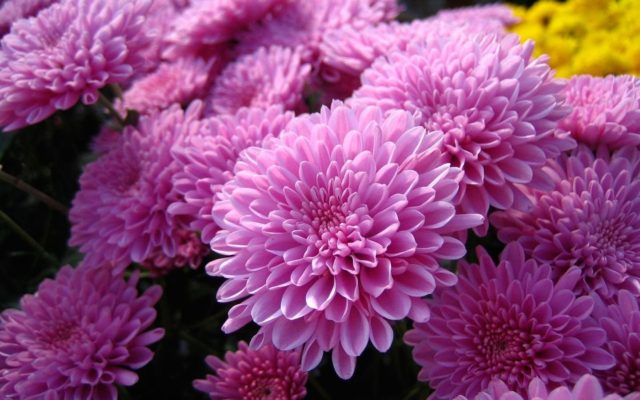Content
While chrysanthemums are considered highly adaptable plants, they still need to be properly cared for. Proper planting, watering and feeding will enable growth and prevent damage from pests and diseases. Flowers are quite capricious to the composition of the soil, so timely fertilization helps the culture to develop normally when transplanted to a new place and will increase the flowering time. It is especially important to properly feed the chrysanthemums in the spring, after the snow thaws.
Features of feeding chrysanthemums
Chrysanthemums are multi-branched plants with a massive stem and many leaves. Fertilizing a crop has several nuances:
- Do not apply fertilizer too deep into the planting hole. The seedling must be placed at a moderate depth, sprinkle the root system with earth, and then distribute the fertilizer around the perimeter of the groove.
- The time of the first feeding is after 7-10 days from the moment of planting.
After the first fertilization, potash and phosphorus compounds should be added every 10 days.
- During the period of active growth of roots, foliage and shoots, the culture is fed with organic matter. The best option is mullein fertilization. 1 liter of infusion is mixed with 10 liters of water. One copy takes about 450-500 ml.
- For the growth of green mass, chrysanthemums need to be fed using nitrogen compounds.
- Fertilizers should not be applied during flowering.
- The development of chrysanthemums is well influenced by the combination of organic and complex mineral products.
- When feeding a culture, it is important to ensure that the solution does not touch the leaves, this can provoke a burn.
- It is necessary to make the compositions exclusively at the root.
You will also have to ensure that the soil is moist when feeding: the ideal time is after precipitation or watering.
How often to feed chrysanthemums
The first time a chrysanthemum is fed immediately after planting in the soil. The soil is fertilized with mineral or organic substances with superphosphate. The next introduction of the composition into the soil is carried out in the third week from the moment of planting. It falls on the growing season. Therefore, flowers need complex fertilizers to improve growth and strengthen the root system.
The third time the chrysanthemum is fed in August, before flowering, during the budding period. It will be useful to add organic matter to the soil with phosphorus sulfates and potassium salts.
Fertilizers for chrysanthemums
There are several main types of chrysanthemum food. For this, you can use both mineral and folk remedies.
Mineral fertilizers
This composition is used during the growing season. The content of the required amount of macro- and microelements contributes to the improvement of the decorative qualities of the culture.
Some of the most famous and effective drugs are Kemira and Kemira Lux, which stimulate active growth and normalize development. The product must be diluted in strict observance of the proportions indicated in the instructions.
To increase the duration of flowering, you should feed outside the roots, using the growth stimulator "Bud" with sodium salts of gibberlinic acids. The drug is also rich in:
- humates;
- microelements: boron, copper, manganese;
- vitamins;
- polysaccharides.
The product must be diluted in a ratio of 1 g to 1 liter of water. You need to process the buds twice.
Folk fertilizers
In addition to purchased mineral preparations, gardeners recommend feeding the culture and folk remedies.
One option is nettle, which contains nitrogen, sodium and potassium. Helps to strengthen the immune system and the decorative qualities of the plant. Fertilizer preparation is carried out in several stages:
- It is necessary to cut the nettle bushes without seeds and remove the damaged parts.
- Grind raw materials.
- Fill the bucket 2/3 with the resulting material.
- Pour in warm water and cover with plastic wrap.
- Place in a bright place and stir every day.
In addition to nettle, chamomile, shepherd, wormwood, and coltsfoot are suitable for use. It is important that there are no seeds on the raw materials. Insist 5-10 days. The state of readiness can be recognized by its appearance: if the foam has ceased to appear, and the liquid has acquired a light brown color, the product can be used. The resulting mixture is diluted in a ratio of 1/10 and chrysanthemums are fed every 2 weeks. At the end of the procedure, the soil is well moistened.
Another effective option is to combine stinging nettle and dandelion. The method of making raw materials is identical: plants without seeds need to be crushed and dried a little.
At the bottom of the container, first place the dandelions (about 1/8 of the total volume). Then add 1/2 tsp nettle, add water and add a little humate (1 tsp. Per 10 l). The mixture should be insisted for 5 days. If desired, you can add ash or Cinderella fertilizer to the composition.
How to feed chrysanthemums in the garden
Depending on the stage of development of the chrysanthemum and the season, fertilizers must be alternated. It is important to take into account the rules of the procedure.
How to feed chrysanthemums in the fall
It is important to remember that in the autumn (especially in September), chrysanthemums should not be fed with nitrogen: this can lead to the death of the plant. At this time of the year, it is optimal to fertilize the crop with bone meal and ash. They decompose easily and are well absorbed by the plant.
How to feed chrysanthemums in spring after winter
By properly feeding chrysanthemums in the spring, the culture can be provided with abundant and long flowering until autumn. In spring, flowers especially need nitrogen, which must be added after watering: this will ensure rapid growth of the leaves and create favorable conditions for flowering.

It is important to control the quality of the soil: if the acidity of the soil is increased, it must be mixed with wood ash and sand
In the spring, the plant must be fed with manure and humus. At the initial stage of the growing season, it needs mineral fertilizers and wood ash. Varieties with small flowers require the following ratio of nitrogen, phosphorus and potassium: 25/25/45, and tall species - 50/25/25.
How to feed homemade chrysanthemum
Indoor chrysanthemums, like garden varieties, have their own nuances of feeding. It is important to observe the timing of plant fertilization: untimely feeding with potassium or phosphorus can lead to early flowering of the crop.

Homemade chrysanthemum should be fed with potassium monophosphate or other fertilizers based on potassium, phosphorus or nitrogen.
Top dressing of an adult plant is carried out every 10 days, during the period of active growth of leaves and shoots. The best option is organic products in liquid form. The flower is fed until buds are formed.
How to properly feed chrysanthemum
To get beautiful and healthy chrysanthemums, you must follow the instructions for feeding the plant. Before planting a flower in the ground, it is enriched with fertilizers. Be sure to use cow dung and chicken humus, which are good compost options.Half a bucket of raw materials must be poured with water (10 liters) and defended for a week to remove excess ammonia. The resulting mixture is diluted in water in a ratio of 1/10, about 1 liter of the mixture is consumed per plant.
Do not use fresh mullein: it contains a lot of ammonia, which can lead to the death of the root system.
After planting seedlings in the soil, they must be fed with a mineral complex with supersulfate: the first time - a week after planting, and the next - every 10 days. If phosphorus has not been added on time, it must be added to the liquid feed. To avoid burns, chrysanthemum should be fed gently, to the very root, avoiding getting the product on the stem, leaves and buds.
Useful Tips
To make feeding chrysanthemums for fast flowering more effective, you should follow a few simple tips:
- The composition of the soil must correspond to the selected variety of chrysanthemum.
- It is necessary to make funds with an orientation to the season, needs and stage of plant development.
- Chrysanthemums need to be fed after precipitation or watering, trying to evenly distribute fertilizers.
- To avoid scalding the root system, the soil must be watered before feeding the plant. This will allow the product to be absorbed evenly and give the plant all the necessary substances.
- You should not regularly feed the homemade chrysanthemum after the formation of buds, as this can negatively affect the duration and splendor of flowering.
- Before the main top dressing, the soil should be fertilized with potassium monophosphate: it includes nitrogen, phosphorus and potassium in a ratio of 1/3/2. The agent is diluted in water in a ratio of 1/10 and applied to the ground every 10 days.
The main fertilizer is also allowed to be diluted with chicken or cow droppings. When the first buds appear, the feeding is stopped.
Conclusion
In order to properly feed chrysanthemums in spring, it is important to know the basic rules and nuances of crop fertilization. This type of plant is quite resistant to changes in weather conditions, however, fertilizers should be applied to the soil regularly, according to the instructions. Feeding chrysanthemums during flowering is strictly prohibited. It is also important to make sure that the fertilizer does not get on parts of the plant, as this can provoke a burn.









